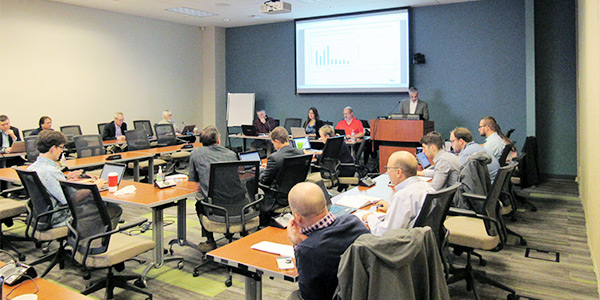By Amanda Durish Cook
CARMEL, Ind. — MISO has mostly focused its multiyear resource availability and need initiative on big-picture solutions, but RTO staff now say they will zero in on three short-term fixes that can be rolled out early next year.
The shift comes after stakeholders expressed the need for near-term improvements in MISO’s effort to address the growing mismatch between its changing resource availability and demand. (See MISO Narrowing Options on Resource Availability Fix.)
“We agree and we’d like to take some near-term action to give us the space to work on holistic solutions,” MISO Executive Director of Market Development Jeff Bladen said during a Nov. 1 Reliability Subcommittee meeting. “We do need the operational breathing room to work on those long-term solutions.”
MISO will likely make a FERC filing for short-term solutions before the end of the year while spending “the bulk” of 2019 on longer-term improvements, Bladen said. MISO’s near-term objective is to make 5 to 10 GW of additional supply more available by the spring, focusing on stricter load-modifying resource (LMR) obligations, more advanced notice of planned outages to members and firmer planned outage requirements.
“Our goal now is not to get to perfect, but get to better,” Bladen said.
MISO next year expects to focus on how resources are accredited in the annual Planning Resource Auction. Beyond that, Bladen said the RTO will work on new market incentives to spur resource availability and a possible seasonal resource adequacy construct.
Outages
MISO wants to create a region-by-region forward rolling forecast of planned outages in its North, South and Central regions “many, many months in advance,” Bladen said.
The RTO is seeking stakeholder input on the definition of a planned outage and the lead time required. The Tariff does not currently spell out a notification period for planned outages, instead leaving stakeholders to interpret the NERC standard of “well in advance.”
Bladen said MISO received suggestions to deem any outages submitted less than a month in advance as “forced.” Stakeholders have also asked the RTO to consider transitioning to a “total” outage rating for generators that includes planned outages and derates, not simply a forced outage rate.
But Bladen said MISO’s recommendation is to consider all outages and derates as forced outages only during periods of low availability of capacity reserves unless the asset owner has provided ample notice of a planned outage. The RTO has not yet determined a possible notification lead time, nor has it defined what would constitute “low reserves,” though Bladen said it may require a 120-day notice period for an outage to be considered planned and anywhere from 5 to 7% in available reserves before MISO declares low availability.
WPPI Energy’s Valy Goepfrich said the RTO could also simply increase its expected forced outage rates for generators.
Bladen said MISO currently experiences a “double camel’s hump” of planned outages in April and October, when maintenance outages spike. He said increasing outages, combined with diminishing reserves, increase the potential of firm load shedding.
Xcel Energy’s Kari Hassler said the RTO could request that generation owners smooth out the two concentrations of outages during the year.
“This is direct correlation of our aging fleet. … It’s something we have to account for in operations,” Bladen said, adding that MISO’s improved transparency around planned outages will require a “heavy lift” from member utilities. He said the RTO’s planned outage data are only as good as what generation owners provide: “If we don’t know outages are coming, we can’t” inform stakeholders.
Minnesota Public Utilities Commission staff member Hwikwon Ham pointed out that multiple generators that were in poor condition have retired in the past few years.
Bladen said that while a transition to a newer generation fleet is a possibility, MISO should work proactively with what generation it has now to ensure reliability while fleet evolution continues.
“We have to account for these trends, even in the short term. We can’t assume a younger fleet, even if the queue tells us that’s on the horizon,” Bladen said. He also noted MISO is seeing more new resources categorized as LMRs, available only in emergencies.
LMRs
MISO is also recommending calling on long-lead-time LMRs ahead of an emergency declaration rather than after. Some stakeholders have asked that LMRs meet a defined response time, perhaps two hours. Bladen said that was something for future consideration but not yet a MISO recommendation. He also said the RTO recommends requiring LMRs to participate in annual testing of their load-tempering capabilities.
Occidental Petroleum’s Suzanne Mottin said MISO’s suggestions were “concerning.” She said Occidental’s LMR service comes with a contract with its utility and guarantees a notification time. “I don’t know how you roll this out with these contracts,” she said.
Coalition of Midwest Transmission Customers attorney Jim Dauphinais pointed out that LMRs are already subject to performance penalties not applicable to other classes of MISO generation.
Bladen said MISO is seeking that and other stakeholder feedback, noting the RTO is not aiming to make LMR participation so “onerous” that most entities are unlikely to sign up.
MISO will also undertake capital spending next year to make it easier for asset owners to communicate through the LMR availability reporting platform. Stakeholders have criticized the usability of the RTO’s current setup.
Bladen also asked for stakeholder feedback on MISO’s recommendation to issue earlier instructions to LMRs in anticipation of tight operations.
“What we’re talking about is the operators being more ready to call on LMRs. They’re pretty smart, and they can see those things in advance,” Bladen said.
MISO will schedule a stakeholder workshop in late November to go over more specific proposals on LMRs and outages, Bladen said.






